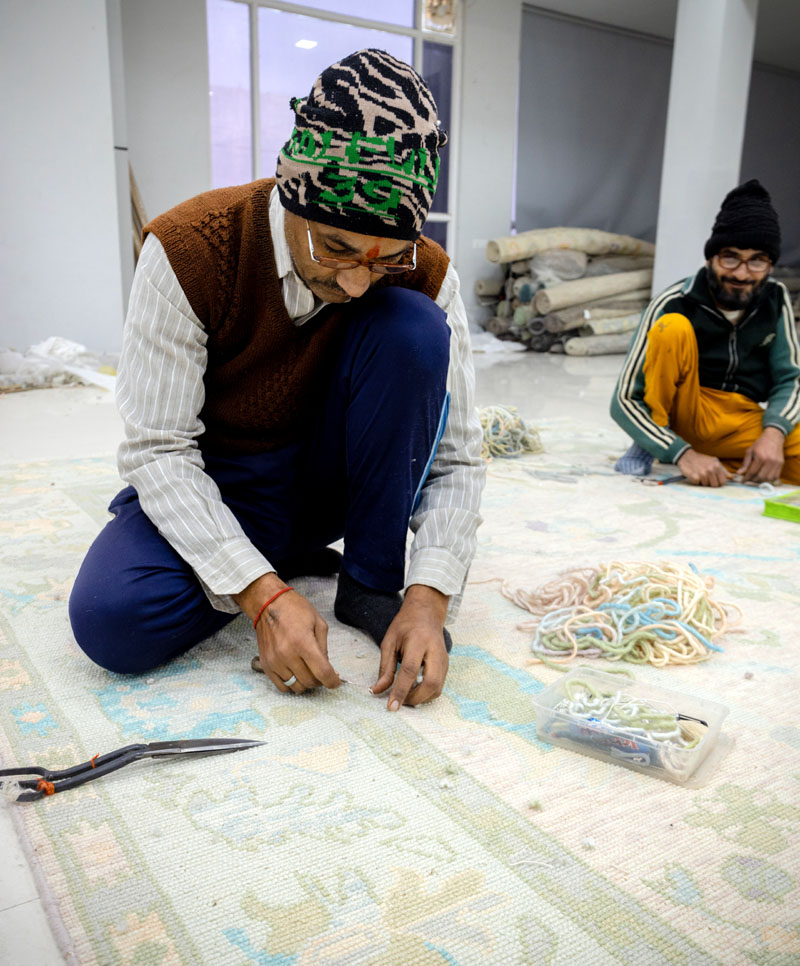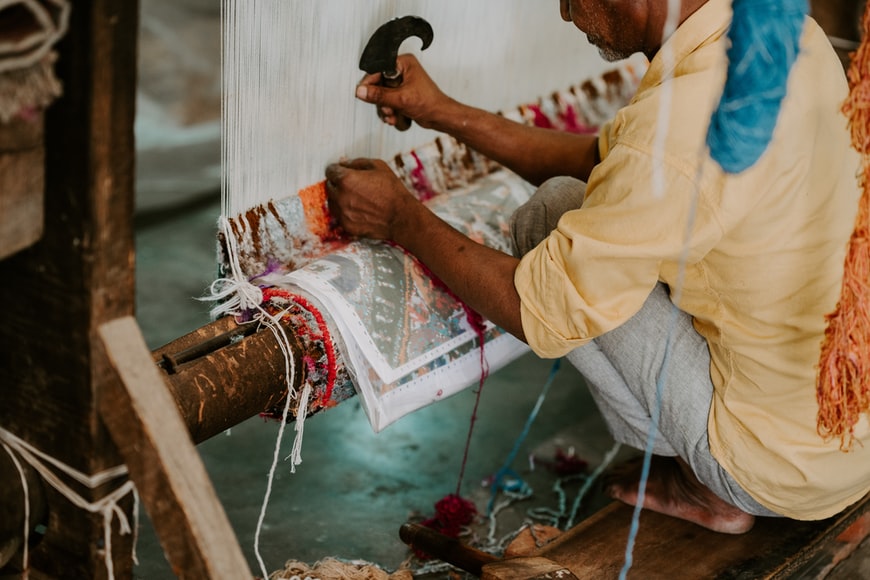No products in the cart.
A. Before Weaving
In the creation of a single handcrafted rug, a symphony of 180 skilled hands converges, a testament to the craftsmanship that is both intricate and irreplaceable. Each of the 90 individuals involved possesses a unique skill set, honed over years of dedication and expertise.
This decentralized model of craftsmanship unfolds step by step, requiring a harmonious collaboration of specialists, connected by bridges of compassion, empathy, and love. The quality achieved through such a meticulous process is unparalleled, a true embodiment of the artistry invested in each rug.
Sourcing of Raw Material:
The soul of handcrafting lies in the raw material transformed into an art form itself.
Wool:
Chokla Wool, the epitome of Indian rug excellence, is procured through a biannual auction in Bikaner. This wool, reflecting the seasonal shearing of sheep, is a blend of textures and qualities meticulously sorted by hand, preserving the traditional expertise of the local artisans.
Merino Wool:
Imported from New Zealand, it graces the finest 14/14 quality carpets and contributes to exquisite wool blends sourced from 18 different countries.
Silk:
Chosen for its utmost quality, silk is imported from China and sourced from trusted traders within India.
Carding & Spinning:
The journey of handpicked wool takes an artistic turn in the hands of Katwari, a rare artisan in India. Through carding, a meticulous process of layering and brushing, she transforms the wool into uniform strands. The spinning wheel, a symbol of India’s rich heritage and struggle for independence, weaves the wool into a yarn that boasts durability and a remarkable texture. Over 3,000 skilled artisans contribute to this unique craftsmanship.
Dyeing:
Rug dyeing emerges as a traditional art, a canvas for artisans to create decorative masterpieces. Yarn is segregated before undergoing the dyeing process, with lighter wool embracing lighter hues and darker wool absorbing deeper tones. The blend of different wools modulates the final texture, balancing between bristly and soft.
Raw colors, sourced from Colourtex and Huntsman, are transformed into a palette of over 3000 shades through unique recipes. These GOTS-certified, eco-friendly dyes ensure the longevity of colors without bleeding or damaging the yarn, resulting in rugs of exceptional durability.
The artisans meticulously wind the yarn on a wheel-like frame, submerging it into boiling vats of dye to embed its intended color. Hung to dry in the sun, each batch of yarn carries inherent color variations, contributing character to the rug and echoing the nuances of wool aging and raw material preparation. Rugs with this distinctive effect are celebrated as Abrash or Antique, telling stories through their vibrant hues and textures.

B. WEAVING
In the annals of Indian history, the weaver was once deemed untouchable, a misinterpretation that belied the true essence of their skill—an artistry that transcends definitions. A rich tapestry of weaving techniques unfolds, each contributing to the diverse world of rugs, where the chosen technique becomes the arbiter of quality, design, price, and durability.

Hand-Knotted: An artist painstakingly ties unique knots on each warp thread, line by line, on the loom, a hallowed platform for creative expression. When every line is finished, a weft thread holds the complex pattern in place, transforming the rug into a work of art that perfectly captures the talent and labor of the hands that created it.
Hand-Tufted: With the use of a tufting gun, the artist meticulously outlines the intended design by tufting yarn into the cloth to give it life. The final rug design is a visual symphony created by the painstaking color dance guided by the outline. The rug design is a kind of art that combines creativity and precision.
Hand-Loom: The warp and weft entwined in a dance that is similar to weaving textiles on a handloom, producing a sturdy fabric. The yarn used in the rug, which is woven through the interlocking layers, is evidence of the weaver’s talent, turning threads into a visible representation of artistry.
Flat-Weave: In this method, a canvas made of interlocking warp and weft threads is created. Threads entwined with colors, and the various interlocking styles produce patterns. This technique, which is both complex and visually striking, results in a rug in which every thread is a brushstroke on the weaver’s imaginative canvas.
In the realm of rug weaving, each technique is a chapter, a legacy handed down through generations. It’s a celebration of hands that defy definitions, weaving stories, traditions, and innovation into the very fabric of these timeless creations.
C. FINISHING
Within the sanctum of carpet creation, a meticulous journey unfolds through 18 finishing steps, transforming threads into masterpieces that radiate perfection. Executed entirely by hand, this intricate process demands a month-long commitment to ensure the carpet gleams with flawless brilliance.
Measurement:
Navigating the idiosyncrasies of hand-knotting, precise measurements guarantee the carpet aligns with the intended standard sizing, harmonizing the diverse dimensions.
Knot Counting:
Every knot, meticulously woven, undergoes scrutiny as artisans count each line, ensuring the carpet faithfully embraces its intended design.
Pile Height Checking:
An initial assessment of pile height becomes a strategic move to optimize yarn usage and secure quality in subsequent finishing steps.
Raffu – Repairing:
Crafted by the “doctors of rugs,” this step employs surgical precision with a needle and thread to repair discrepancies in knot count and pile depth.
Thukai – Knot Beating:
Addressing the imprecisions of hand-knotting, craftsmen utilize iron nails and hammers to align knots along warp and weft, preserving the intended pattern.
Kachi Kainchi – First Shear:
A gyro-equipped shearing machine, guided by skilled hands, evens out minor differences in pile height, ensuring a uniform carpet surface.
Sua Birai – Design Correction:
Artisans untangle intermingled yarns with a large skewer, providing clarity to the rug’s design by navigating through a longer pile height.
Back-burning:
Subjecting the carpet to controlled flames fortifies knots, enhancing durability, and singes loose strands for a resilient finish.
Back-burn Cleaning:
Brushing off singed particles, this step imparts a pristine appearance to the back of the carpet.
Dipping:
A cleansing soak clears impurities as the carpet absorbs fluid, laying the foundation for a rejuvenated finish.
Washing:
An intricate dance of washers, pouring water and cleansing solution with precision, elevates washing into an art form, enriching the rug’s strength and aesthetics.
Khinchai – Stretching:
Post-wash, the carpet undergoes stretching on an iron frame, balancing and tightening knots to achieve the prescribed size.


Cutting:
Artisans liberate the carpet from its loom binding, allowing freedom of design and enhancing durability.
Binding:
Edges are meticulously bound, showcasing a range of patterns for width and a standardized style for length, fusing tradition with modern aesthetics.
Pucci Kainchi – Final Shearing:
In the ultimate shearing phase, craftsmen set the measured pile height, categorizing the carpet for sale.
Kalam Birai – Detailing:
A meticulous process where an artisan sharpens the design, untangling interlocked yarn knot by knot to achieve clarity.
Chinte Nikalna – Snipping Visible Cotton:
Artisans meticulously remove excess cotton strands, combing through the pile to perfect every detail.
Carving & Embossing:
Khadi Gultarash, or carving, introduces cuts in the design, while Put Gultarash, or embossing, crafts a three-dimensional effect, elevating the rug into a work of art.


